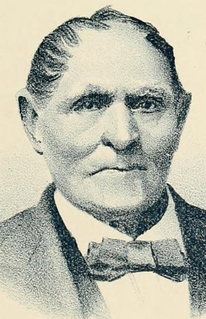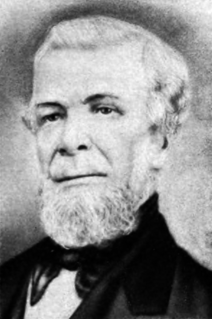
The Flat River is a tributary of the Grand River in the western part of the U.S. state of Michigan. It rises as the outflow of First Lake, the last in a chain of geographically close, connected lakes known as Six Lakes in Belvidere Township, west of Edmore in Montcalm County. It flows mostly south and slightly west through Montcalm County, Ionia County, and Kent County, flowing into the Grand River in Lowell. Other cities it flows through along the way include Greenville and Belding.
Frederick, Michigan, also known as Casino, was a community in Clinton Charter Township of Macomb County, Michigan in the U.S. state of Michigan. It was located on an oxbow of the Clinton River southwest of present-day Mt. Clemens.

Columbia Lancaster was an American lawyer and politician who served as the first Delegate from the Territory of Washington to the United States House of Representatives.
The Northern Central Michigan Railroad (NCMR) was a railroad line in the U.S. state of Michigan. The line ran from Lansing to Jonesville, then returned north from Jonesville to Albion and Eaton Rapids before closing the loop in Lansing. The NCMR had a short life as an independent company, becoming part of the Lake Shore and Michigan Southern Railway in 1871 and then consolidating with the New York Central Railroad in 1914.

The 1st Michigan Legislature, consisting of the Michigan Senate and the Michigan House of Representatives, met in Detroit in three sessions between November 2, 1835, and July 26, 1836, during the first year of Stevens T. Mason's governorship of the (prospective) state.
Conrad "Old Coon" Ten Eyck, also known as Conrad TenEyck or Teneyck, was an American politician in the U.S. state of Michigan in the mid-19th century. He served as a member of the Michigan Senate starting in its inaugural session in 1835, and as a member of the Michigan House of Representatives in 1846.
Charles Chandler Hascall was an American newspaper publisher and politician. He served in the Michigan Senate during its first session after adoption of the state constitution.

Townsend E. Gidley was an American politician who served eight terms in the Michigan Legislature and was instrumental in the drafting of the state's first constitution.
Jonathan Prescott Fay was an American physician and politician who served in the Michigan House of Representatives in its first session following adoption of the state's constitution in 1835, and died while in office.
George Howe was an American politician who served in the Michigan House of Representatives immediately after adoption of the state's first constitution.

The Sixth Michigan Territorial Council was a meeting of the legislative body governing Michigan Territory, known formally as the Legislative Council of the Territory of Michigan. The council met in Detroit in two regular sessions, one extra session, and one special session between January 7, 1834, and August 25, 1835, during the terms of George B. Porter and Stevens T. Mason as territorial governors.

M-343 is a state trunkline highway in Kalamazoo County, Michigan. It runs for almost eight miles (13 km) along Gull Road between the northeast side of Kalamazoo and continues through rural areas on the way to Richland. The highway was created in January 2019 from a section of M-43 after that highway was rerouted in the aftermath of a series of jurisdictional transfers in downtown Kalamazoo. It had been a part of the state highway system for a century under its previous number until it was given its current designation.
The Michigan Territorial Council, known formally as the Legislative Council of the Territory of Michigan, was the legislative body of the Territory of Michigan from 1824 to 1835, when it was succeeded by the Michigan Legislature in anticipation of Michigan becoming a U.S. state. A session of the council including only members from what would become Wisconsin Territory met in 1836.
The Seventh Michigan Territorial Council, also known as the Rump Council, was a meeting of the legislative body governing Michigan Territory in January 1836, during the term of Acting Governor John S. Horner. At the time, most of Michigan Territory was awaiting admission to the union as the state of Michigan and had already seated its new state legislature. This was the final session of the Council and consisted only of members from the "contingent remainder" or "rump territory"—the remaining counties that formed the new Wisconsin Territory later that year.

The Fifth Michigan Territorial Council was a meeting of the legislative body governing Michigan Territory, known formally as the Legislative Council of the Territory of Michigan. The council met in Detroit in two regular sessions between May 1, 1832, and April 23, 1833, during the term of George B. Porter as territorial governor.
The Fourth Michigan Territorial Council was a meeting of the legislative body governing Michigan Territory, known formally as the Legislative Council of the Territory of Michigan. The council met in Detroit in two regular sessions between May 11, 1830, and March 4, 1831, during the terms of Lewis Cass and George B. Porter as territorial governor.
The Third Michigan Territorial Council was a meeting of the legislative body governing Michigan Territory, known formally as the Legislative Council of the Territory of Michigan. The council met in Detroit in two regular sessions between May 5, 1828, and November 5, 1829, during the term of Lewis Cass as territorial governor.
Robert C. Hoard was an American smelter, attorney and politician from Mineral Point, Wisconsin Territory who served in the legislature of the Territory and held other local offices, including that of militia captain during the Black Hawk War.

Stevens T. Mason, also known as the Stevens T. Mason Monument, is a monumental statue in Detroit, Michigan, United States. The monument was designed by sculptor Albert Weinert and architect H. Van Buren Magonigle in honor of Stevens T. Mason, who had served as the first governor of Michigan in the mid-1800s and is notable for being the youngest person to ever serve as the governor of a U.S. state. Mason's remains are interred underneath the monument, which is located in Capitol Park, the site of the former state capitol building. The monument was dedicated on Memorial Day 1908.
Duncan Township was a civil township in Cheboygan County in the U.S. state of Michigan. It was first established on August 23, 1854. As the second township in the county, it consisted of all parts of Michigan east of the Cheboygan River. Portions of this township were later incorporated into Benton Township in 1871, Grant Township in 1879, and Presque Isle County. The remnants of Duncan Township were combined with and incorporated into Benton Township on March 7, 1887.







